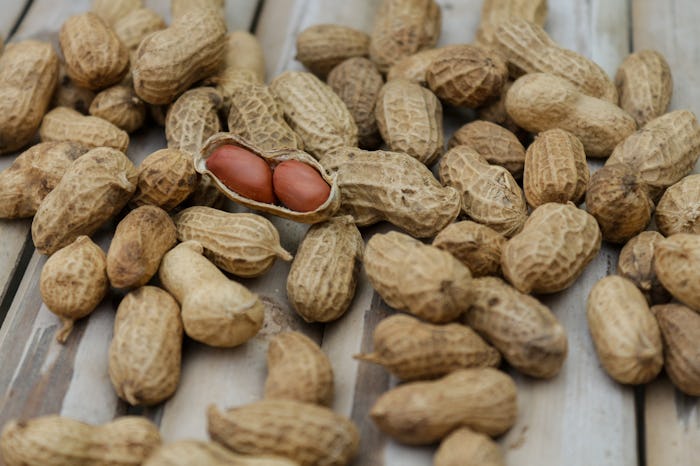Life
9 Ways To Safely Test Your Infants For Food Allergies
Introducing your child to new foods can be a fascinating part of the parenting process. After all, kids can have amazingly strong opinions about apples, sweet potatoes, and avocados, as well as any other food you give them. However, many parents have understandable concerns about the potential for bad reactions to certain foods. There are, fortunately, ways to safely test your infants for food allergies.
If you feel like today's parents have to deal with potential food allergies more than previous generations, you may be on to something. According to the Centers for Disease Control and Prevention (CDC), from 1997 to 2007, there was an 18 percent increase in the incidents of reported food allergies in children under the age of 18. And some of these reactions were serious. As further noted by the CDC, from 2004 to 2006, around 9,500 hospital discharges were related to food allergies in children. This is not a case of parental overreaction; food allergies can be very real health concerns.
Although you may be tempted to keep your kid away from peanuts and honey forever, there are ways to safely test your baby's tolerance for certain foods. You may need to enlist the help of your pediatrician or a food allergist, but for the most part testing your kid for potential food allergies involves careful timing, tiny portions, and close observation. Chances are, you can detect any potential food allergies before they become a problem.
1Introduce New Foods Gradually
Sure, it's tempting to give your kid a bite of everything as soon as he is old enough to try out solid foods. But according to WebMD, it's a good idea to introduce new foods one at a time. This way, if your baby does develop a bad reaction to something, you will know which food is the most likely culprit.
2Monitor Your Child For Symptoms Of Allergies
When giving your baby new foods, you can keep an eye out for any sign of an allergic reaction. As explained in Everyday Health, if your baby is allergic to a certain food, this may show up in the form of a skin rash, breathing difficulties, congestion, or problems with digestion. Hopefully, your baby will not have any of these symptoms, but it's a good idea to know what may indicate a problem.
3Introduce Foods At Home
If your baby does experience an allergic reaction, you probably don't want to deal with it at a restaurant. According to the Mayo Clinic, it's smart to introduce your baby to new foods at home, ideally when you have an oral antihistamine on hand. This may help you avoid putting unnecessary stress on you, your baby, and an unsuspecting waitstaff.
4Take Care With Peanuts
A serious food allergy can change your entire family's eating habits, and most parents are aware of the dangers a peanut allergy can present. With that in mind, you may want to take extra-special precautions when giving your little one peanuts or peanut butter for the first time. As noted in Everyday Health, you can speak with your pediatrician about your kid's risk factors for the allergy, and then introduce him to peanut butter in very small quantities. Hopefully he will be able to safely enjoy PB&J sandwiches in no time.
5Use Blood Tests When Appropriate
If your kid does exhibit potential signs of an allergic reaction to certain foods, then you may want to visit an allergist for further testing. When appropriate, your allergist may use a blood test to learn more about your kid's reactions to certain foods. It's a simple way to gain a lot more insight into your baby's food tolerances.
6Consider The Skin Prick Test
Skin testing is another way pediatricians may learn more about your child's allergy. As explained in Kid's Health, when performing a scratch test, your doctor may scratch your child's forearm or back with a tiny amount of the potential allergen. If red spots form, then this is the sign of a probable allergy. Another upside of this test: even if your child has a bad reaction, you're surrounded by medical professionals who can immediately help.
7Try Oral Food Challenges
Although blood and skin tests are critical, sometimes the best way to test for a food allergy is by feeding the potentially troublesome food to your child. As noted by Kids With Food Allergies, your kid may need an oral food challenge, in which he ingests a bit of the offending food in a clinical setting to safely determine whether he exhibits signs of an allergic reaction. Again, this is a safe method to try out because your little one will be under medical supervision the entire time.
8Work With Your Pediatrician
No one knows your baby's health like your personal pediatrician. Because many factors may influence your infant's propensity for food allergies, such as a family history of allergies or even symptoms of eczema, a doctor who has a thorough understanding of your child's medical history is invaluable, according to US News. Nothing can take the place of an informed medical decision.
9Avoid Self-Diagnosis
Lastly, it's smart to leave the official allergy diagnoses to the professionals. According to Food Allergy Research & Education, Inc., it can be easy to misdiagnose a different type of food disorder for food allergies. To be on the safe side, present all evidence to your pediatrician to get an informed diagnosis.
